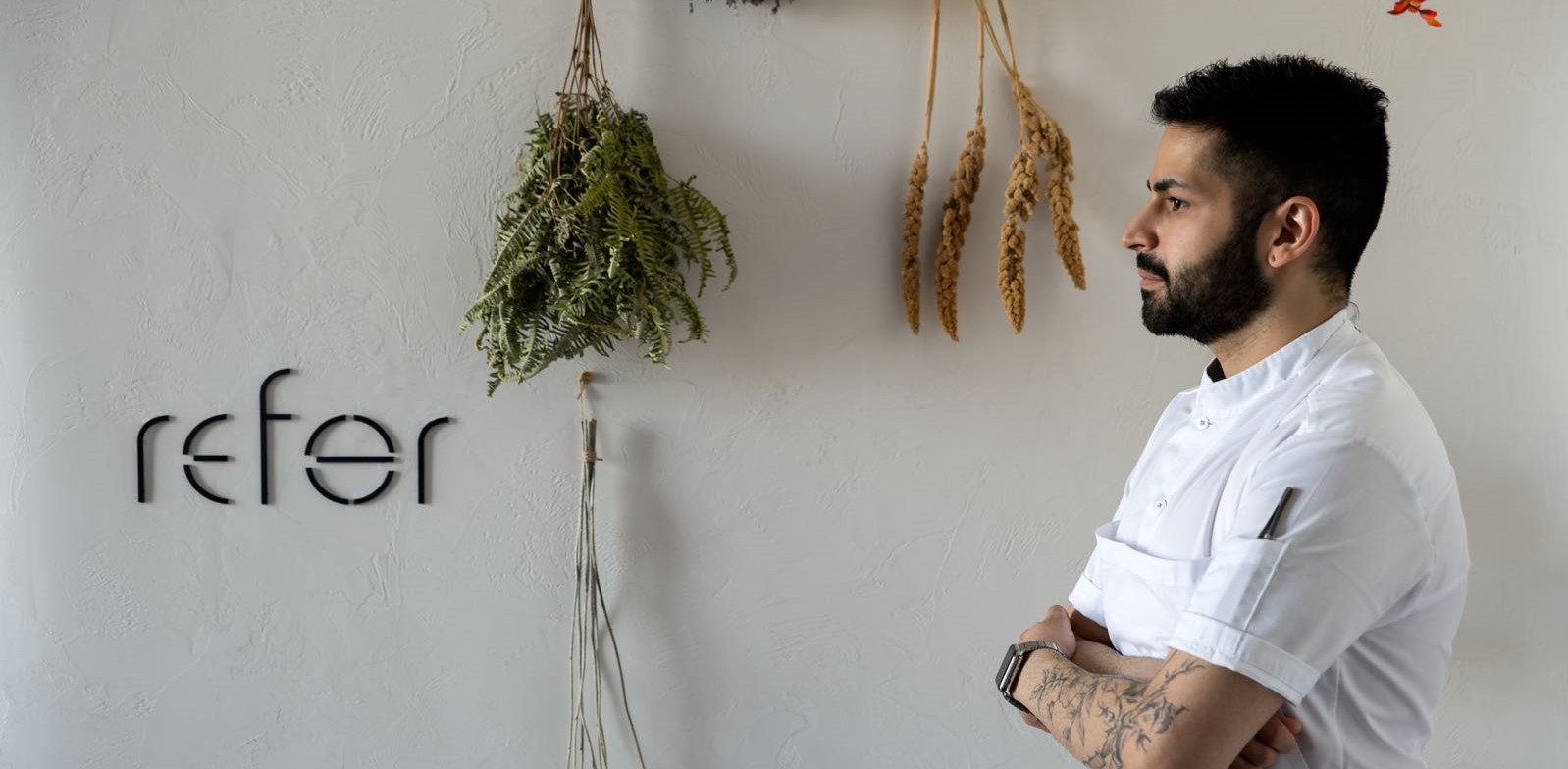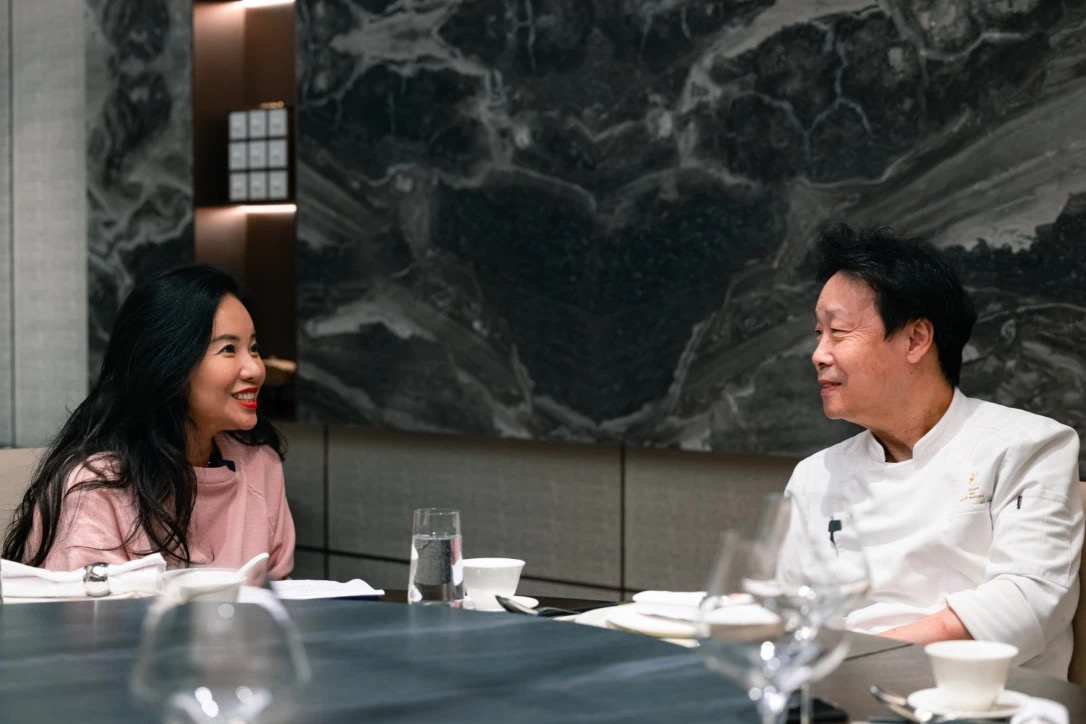One night in Beijing

Talib Hudda


Environment
Thereupon, I visited Refer in vigilance. As Western food in Beijing is still tend to be conservative, attempting such a ‘borderless’ Nordic restaurant is not something all investors would do.
Refer Beijing


Environment
The food
We sat down to dinner. Normally, I wouldn’t comment on bread, but Refer’s delicate bread marked a magnificent entrance. Like Talib’s boundless style, Refer’s range of bread covered styles from Nordic countries, Japan and France: gluten-free baguette, sourdough and Tangzhong milk bread. The pairing butter were French unsalted butter, cultured fresh butter, together with yellow rose fermented honey, which you could only see at a Michelin three-starred restaurant.

Sea Garden | Spot Prawn, Nasturtium, Tomato & Kaffir Lime

Red Puzzle | Blue Lobster Claw, Red Onion, Purple Shiso, Watermelon Radish
Next, you’ll find more than six kinds of ingredients and herbs in each of his dishes, some even as many as eight or ten, not including carefully blended sauces. You will be served accordingly as the waiters present each precious plate with professionalism and friendly smiles, and the dining experience is way more joyous than it lets on.
Then there was this inventive dish that features Chinese mochi (rice cakes) and the grappling ‘little lobster’ – crayfish, China’s seasonal specialty that’s usually spicy and great for casual gatherings. Only Refer’s version is upgraded to be more luxury. Chinese mochi and Canadian lobster coming together, new but without a hint of incongruity. The blissful, harmonious and fresh flavours of the full, fatty lobster and sticky mochi were served with Japanese dashi beurre blanc. A long-standing classic at Refer, this dish is not just loved by Chinese foodies, but suitable for almost every appetite.
The lamb chops that day were perfectly cooked and served with a plethora of ingredients such as sunflower seed shouyu, grilled maitake in duck fat, salted turnip, foie gras, bay leaves and duck blanquette. Salted turnip and foie gras were unexpectedly refreshing, bold creation but not overly ornate or disharmonious.
Born and raised in a country that’s known for being the mosaic formed by its rich multi-ethnicity culture from China and other Asian countries, Talib has even more in-depth understanding of local ingredients after having spent four years in China. That afternoon in the kitchen, I saw Talib honing over and over again about presentation and dish layout. Grilled maitake mushrooms in duck fat were exuberant of fragrance and slightly crispy in the mouth.
Dessert was equally stunning. The Berrymisu that combined berries and tiramisu, may sound a bit dated but unexpectedly won my heart. The combination of 72% cacao chocolate, chevre blanc, peanuts and mixed berries creates a multi-layered texture and contrasting flavours. Dessert is supposed to be the most beautiful dish in a course meal, but the Berrymisu, not so outstanding compared to other beautiful dishes, was simple yet delightful.

Handful of Spring | Sweet Peas, Wasabi, King Crab, Watercress & Pickled White Asparagus

Foie Gras of the Sea | Monkfish Liver, Sauternes, Seabuckthorn & Lemon Marigold

The Lobster Dish | Lobster with Mochi & Dashi Beurre Blanc

Solo Dover | Sole, Water-chestnut, Mountain Berry & Lemon, Scallop, Fava Bean & Fennel Ragout

Berrymisu 72% Chocolate, Mixed Berries, Espresso, Chèvre Blanc & Peanut 72%
I would say I’m happy with most dishes I had that day, especially the expertly-handled seafood. Lobsters and scallops all had a slightly transparent centre, and lobster claws had a soft and fibrous texture. Talib’s seafood dishes are ornate but his solid skills of cooking have preserved the freshness of the ingredients.
Refer’s extensive use of pickling is a common food preserving technique in Nordic countries, but it perhaps is more entrenched and has a longer history in Chinese cuisine. A closer look at Refer’s dishes reveals a fusion of Chinese and Japanese styles. Chinese specialty like sweet bean sauce and asparagus lettuce, as well as Japanese ingredients and dashi soups, are easily found here. After all, Japanese food has become a global culinary phenomenon.
Apart from local farm contractors supplying fresh fruits, vegetables and herbs, Refer has capitalized on its reliable sources to procure seasonal, premium-quality ingredients from around the world. The strategy is not strictly farm-to-table, but the dual trajectory has enabled Talib to make his dishes dynamic and more diversified.
Nordic Aesthetics , Asian Soul
Interestingly, Talib’s borderless cooking is indeed hard to define, which may have some traces reflected in his origins and cosmopolitan life experiences. Born in a family that mixes many different countries around the world, including his Indian grandparents, the Canadian-born chef has been passionate about cooking since early childhood. He started cooking with his grandmother at the tender age of six, helping hands in restaurant kitchens at 14 and enrolling into culinary school when he was only 18 years old. After graduation, he started his career working at well-known restaurants around the world and took strict tutorage under several celebrated chefs.
He has since worked in acclaimed restaurants around the world, including Marchal in Copenhagen, where he worked with Ronny Emborg and helped the restaurant earn its first Michelin star. Ronni Mortensen was his co-worker at Marv & Ben in the same city. To broaden his culinary horizons, he also ventured to New York for short stints at the city’s most famous eateries, Café Boulud and Eleven Madison Park.
Talib approaches his cuisine with skilful sophistication and refined maturity, partially thanks to his early experience running chores in restaurant kitchens. Being a 32-year-old young chef, he already has experience cooking for almost 20 years. Many would assume Refer is a Scandinavian restaurant judging by its overarching presentation and culinary style. If I had to categorise it, I would think Refer’s appearance and presentation take reference from Nordic cuisines, yet there is a subtlety in the details between it and Geranium.
Though not having worked with chef Rasmus at Geranium, Talib did work with its sous chef–Ronni Mortensen for a year. That’s probably the reason why Talib takes on his restaurant in a similar approach. Talib shared that what he learned from Ronni was more about managing and operating. Chefs at Refer wear high hats, something not often seen in many neo-Nordic restaurants, perhaps because of their Bocuse d’Or background. Despite being upscale and elegant, Refer executes some of the warmest and most gracious dishes you will ever experience, with just the right amount of seafood and meat for a hearty meal.
Talib sometimes can get competitive, perhaps best demonstrated by the complexity of his dishes. Building on his substantial working experience and personal ideas, Talib has incorporated his four-year Chinese experience into his cooking, honoring local flavours and bringing extra warmth to the dining experience.
Never one to shy away from a challenge, Talib seized the opportunity to make his mark at the BC Team Hot Competition in Canada, taking two awards from 2009 to 2014. He also made presence at the Salon Culinaire Mondial in Switzerland and represented Canada at the most prestigious culinary competition in the world, the Bocuse d’Or in 2011.



Chef Talib Hudda
Talib first moved to Beijing when he was invited to become the executive chef at The Georg by the silverware brand Georg Jensen in 2015. Despite it being his first posting in Asia, he thrived in Beijing’s booming fine dining scene and helped The Georg earn several prestigious accolades for its Nordic cuisine. Later he returned to Copenhage to further his studies at the Michelin two-starred restaurant Alchemist 2.0 before starting his own business in 2020.
Talib Hudda has spent time in many cities around the world and his family’s multi-ethnicity background has given him international values. When asked why his style eventually veered towards Nordic cuisine, he said two years’ experience in Copenhagen had a great impact on him, not just the way locals cook, but his own aesthetics.
Beauty with soul
I asked him if he felt upset about his dishes being called Nordic cuisine, and he said he didn’t want Refer to be clearly defined. Just like the meaning of ‘refer’, ingredients, techniques, aesthetic concepts, anything could become references to inspire creativity. What’s more, he has solid cooking techniques and mature ideas despite of his gentle age. Inspired by many culinary treasures around the globe, he has managed to keep his own boundaries well in place, borderless but substantially real. But for a restaurant, marketing-wise, using such term as ‘borderless’ is a bit of a risk.
Talib Hudda’s sense of aesthetic wows you and is one of his most valuable treasure. I have been thinking that aesthetic sense has long been neglected by many chefs. Without it, one’s feeling of inferiority would prompt copying behaviours. Therefore, it’s not uncommon to see similar aesthetics prevail in many restaurants. But Refer’s aesthetic has a distinctive identity, with minimalist aesthetics exuding from its porcelain tableware to details of the dishes.
Prior to meeting Talib in person, he appeared to be a serious man in photographs, but he was very affectionate in person. During the meeting, I could sense he and his wife have strong bonds with each other. The vessel used for Caviar Cone is a plaster hand model of his and his wife’s hands.
I asked his wife if she felt it was a sacrifice to help Talibrun the restaurant. She said she loved the job there and thanked Talib for being extraordinary in so many ways. She just felt lucky to have Talib in the business. I seemed to catch smiles on their happy faces.
Refer’s interpretation of beauty is not often seen in China. The restaurant has only five tables and one private room, and yes they are hard to secure. But the configuration can help maintain consistency. A Michelin-grade example, well, a solid two stars I’d say.

Picking Flower | Black Currant Ganache, Waxberry Lavender & Pansies

Environment
Having captured common ground between Nordic cuisine and his own aesthetic value, Talib instils open-mindedness and expertise into his cooking, with multicultural approaches and wide-ranging seasonal produce and techniques from different regions such as China and Japan. Many chefs talk about creativity, but more or less lack ingenuity. Refer’s cuisine may be hard to define, but it’s loaded with the chef’s focus and personal style. Dining at Refer would possibly end up feeling overwhelmed by its gastronomic sensation and unique aesthetic.
Talib’s journey to where he is now may have been tagged with ups and downs, but this has in return forged a resilient soul in his cooking, allowing his experiences, ideas and values to become precious works.
For Western restaurants in the capital city of Beijing, Refer is a unique experience and a breeze of novelty. I look forward to seeing Talib reshape the restaurant’s culinary direction with a more refined, creative approach.
Refer
📍5th Floor, Building No.8, TaiKooLi North Chaoyang, Beijing

Reprint or other cooperation matters
Please contact WeChat account:tastytrip2020
Welcome to follow us
Weibo:TastyTrip
Instagram:_tastytrip_










